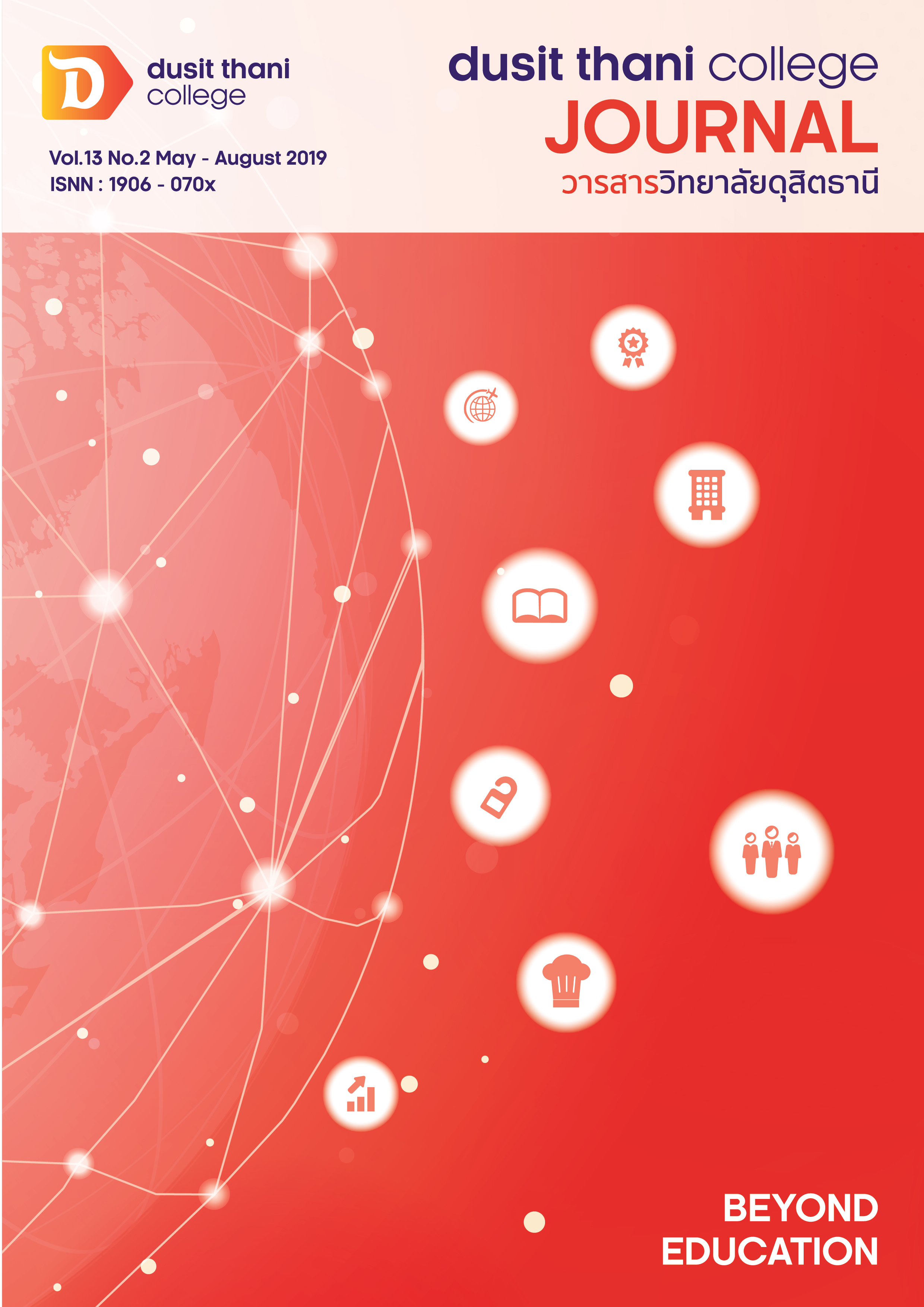แผนการตลาดการท่องเที่ยวสำหรับสถานที่ท่องเที่ยวในแหล่งธรรมชาติ : กรณีศึกษาของบริติชโคลัมเบีย แคนาดา
Main Article Content
บทคัดย่อ
บทความวิชาการนี้ มีจุดมุ่งหมายเพื่อศึกษาแผนการตลาดการท่องเที่ยวสำหรับสถานที่ท่องเที่ยวในแหล่งธรรมชาติ เพื่อตรวจสอบว่าแผนและแนวทางปฏิบัติทางการตลาดนั้นมีผลในการเพิ่มประสิทธิภาพของสถานที่ท่องเที่ยว เอาชนะความท้าทายและคงไว้ซึ่งคุณภาพมาตรฐานของผลิตภัณฑ์และการบริการทางการท่องเที่ยวพร้อมทั้งดึงดูดนักท่องเที่ยวได้อย่างไร รวมถึงเพื่อศึกษาแผนยุทธศาสตร์การตลาดการท่องเที่ยวที่มีประสิทธิผลในการดำรงรักษาสถานที่ท่องเที่ยวพร้อม ๆ กับการพัฒนาคุณภาพชีวิตของคนท้องถิ่น
การท่องเที่ยวสร้างรายได้มหาศาลให้กับสถานที่ท่องเที่ยวและชุมชน ในปัจจุบันโลกาภิวัตน์มีผลทำให้ตลาดการท่องเที่ยวมีการแข่งขันที่สูงขึ้น สถานที่ท่องเที่ยวจำเป็นต้องสร้างความแตกต่างให้กับตัวเองท่ามกลางคู่แข่งขันอื่น ๆ
การวางแผนการท่องเที่ยวนับเป็นสิ่งสำคัญในการส่งเสริมและจัดการสถานที่ท่องเที่ยวอย่างมีประสิทธิภาพในระยะยาว อย่างไรก็ดี มีปัจจัยหลายปัจจัยที่ต้องคำนึงถึงเมื่อวางแผนการท่องเที่ยว
การวางแผนการท่องเที่ยวที่ดีจำเป็นต้องเน้นการทำให้สถานที่ท่องเที่ยวมีความสามารถในการแข่งขัน พร้อมทั้งทำให้สถานที่ท่องเที่ยวและคุณภาพชีวิตของชุมชนมีความยั่งยืน บริติช โคลัมเบีย ประเทศแคนาดาเป็นสถานที่ท่องเที่ยวที่มีชื่อเสียงด้านธรรมชาติ สัตว์ป่า กิจกรรมกลางแจ้งและกีฬา
แผนการท่องเที่ยวของบริติช โคลัมเบียนับได้ว่าเป็นหนึ่งในผลการปฏิบัติงานที่เป็นเลิศ ดังนั้น บริติช โคลัมเบียจึงได้รับเลือกเป็นกรณีศึกษาในการวิเคราะห์การปฏิบัติการที่ประสบความสำเร็จด้านแผนการตลาดการท่องเที่ยวของสถานที่ท่องเที่ยวในแหล่งธรรมชาติ
วิธีการปฏิบัติที่เป็นเลิศนี้มีค่าต่อที่ตั้งทางภูมิศาสตร์ ระบบการเมืองการปกครอง ผู้มีส่วนได้เสีย ปัญหาการท่องเที่ยว กระบวนการวางแผนการท่องเที่ยว เป้าหมายของแผนการท่องเที่ยว การอภิปรายระบบการเมือง แผนการพัฒนาการท่องเที่ยว รวมถึงการวิเคราะห์ด้านสิ่งแวดล้อม สังคม-วัฒนธรรม เศรษฐกิจ และการเปลี่ยนแปลงสภาพทางภูมิอากาศที่มีความเกี่ยวข้องกับการวางแผน เพื่อใช้บริติช โคลัมเบียเป็นตัวอย่างที่ประสบความสำเร็จสำหรับสถานที่ท่องเที่ยวในแหล่งธรรมชาติ บทความนี้ได้กล่าวถึงการใช้แผนและกลยุทธ์ทางการตลาดที่พร้อมใช้งานด้วย
Article Details
นโยบายการพิจารณากลั่นกรองบทความ
- บทความวิจัยและบทความวิชาการทุกเรื่องที่จะได้รับการตีพิมพ์ต้องผ่านการพิจารณากลั่นกรองโดยผู้ทรงคุณวุฒิ (Peer Review) ในสาขาที่เกี่ยวข้อง จำนวน 3 ท่าน/บทความ
- บทความ ข้อความ ภาพประกอบและตารางประกอบที่ลงตีพิมพ์ในวารสารเป็นความคิดเห็นส่วนตัวของผู้เขียน กองบรรณาธิการไม่จำเป็นต้องเห็นด้วยเสมอไป และไม่มีส่วนรับผิดชอบใด ๆ ถือเป็นความรับผิดชอบของผู้เขียนแต่เพียงผู้เดียว
- บทความที่จะได้รับการตีพิมพ์จะต้องไม่เคยตีพิมพ์ เผยแพร่ที่ใดมาก่อน และไม่อยู่ระหว่างการพิจารณาของวารสารฉบับอื่น หากตรวจสอบพบว่ามีการตีพิมพ์ซ้ำซ้อน ถือเป็นความรับผิดชอบของผู้เขียนแต่เพียงผู้เดียว
- บทความใดที่ผู้อ่านเห็นว่าได้มีการลอกเลียนหรือแอบอ้างโดยปราศจากการอ้างอิง หรือทำให้เข้าใจผิดว่าเป็นผลงานของผู้เขียน กรุณาแจ้งให้กองบรรณาธิการวารสารทราบจะเป็นพระคุณยิ่ง
เอกสารอ้างอิง
2. Chen, J. S., Prebensen, N. K., Chen, Y. L., & Kim, H. (2013). Revelation of nature-minded travellers: A study of the Swedish. Tourism Analysis, 18, 651-661.
3. Chi, C. G., Cai, R., & Li, Y. (2017). Factors influencing residents’ subjective well-being at world heritage sites. Tourism Management, 63, 209-222.
4. Dimoska, T., & Trimcev, B. (2012). Competitiveness strategies for supporting economic development of the touristic destination. Procedia - Social and Behavioral Sciences, 44, 279-288.
5. Edgell, D. L., Allen, M.D., Smith, G., & Swanson, J. R. (2013). Tourism Policy and Planning; Yesterday, Today and Tomorrow. New York, NY: Routledge.
6. Fisichelli, N. A., Schuurman, G. W., Monahan, W. B., Ziesler, P. S. (2015). Protected Area Tourism in a Changing Climate: Will Visitation at US National Parks Warm Up or Overheat? PLoS ONE, 10(6).
7. Fitchett, J. M., Grant, B., & Hoogendoorn, G. (2016). Climate change threats to two low lying South African coastal towns: Risks and perceptions. South African Journal of Science, 12(5/6), 1-9.
8. Gaining the Edge (2012). Five Year Strategy for Tourism in British Columbia 2012 – 2016.
9. Healy, N., Riper, C. J., Boyd, S. W. (2016). Low versus high intensity approaches to interpretive tourism planning: The case of the Cliffs of Moher, Ireland. Tourism Management, 52, 574-583.
10. Jovanovic, S., & Ilic, I. (2016). Infrastructure as important determinant of tourism development in the countries of Southeast Europe. Ecoforum, 5(1), 288-294.
11. Kelly, A. B., & Peluso, N. L. (2015). Frontiers of commodification: State lands and their formalization. Society & Natural Resources, 28 (5), 473-495.
12. Koo, C., Shin, S., Gretzel, U., Hunter, W. C., Chung, N. (2016).Conceptualization of smart tourism destination competitiveness. Asia Pacific Journal of Information Systems,
26 (4), 561-576.
13. Li, C.L. (2016) Why do people travel to nature based tourism destinations?. Tourism Travel and Research Association: Advancing Tourism Research Globally. 48.
14. Li, S., & Song, H. (2013). Economic impacts of visa restrictionson tourism: A case of two events in China. Annals of Tourism Research, 43, 251-71.
15. Machnik, A. (2013). Nature-based tourism as an introduction to ecotourism experience-a new approach. Journal of Tourism Challenges and Trends, 6(1).
16. McCreary, A., Fatoric, S., Seekamp, E., Smith, J. W., Kanazawa, M., Davenport, M. A. (2018). The influences of place meanings and risk perceptions on visitors' willingness to pay for climate change adaptation planning in a nature-based tourism destination.
Journal of Park & Recreation Administration. 36(2), 121-140.
17. McLennan, C.J., Ritchie, B.W., Ruhanen, L.M., & Moyle, B.D. (2014). An institutional assessment of three local government-level tourism destinations at different stages of the transformation process. Tourism Management, 41, 107-118.
18. Ministry of Forests, Lands and Natural Resource Operations British Columbia, Canada. (2018).
19. Moghavvemi, S., Woosnam, K. M., Paramanathan, T., Musa, G., & Hamzah, A. (2017). The effect of residents’ personality, emotional solidarity, and community commitment on support for tourism development. Tourism Management, 63, 242-254.
20. Moufida, N., & Achour, M. (2017). The impact of visa facilities on tourism sector Case study for Algeria. 14-28.
21. Moyle, B.D., Scherrer, P., Weiler, B., Wilson, E., Caldicott, R., & Nielsen, N. (2017). Assessing preferences of potential visitors for nature-based experiences in protected areas. Tourism Management, 62, 29-41.
22. Poudel, S., Nyaupane, G. P., & Budruk, M. (2014). Stakeholders’ perspectives of sustainable tourism development: A new approach to measuring outcomes. Journal of Travel Research,1–16.
23. Pyke, S., Hartwell, H., Blake, A., & Hemingway, A. (2016). Exploring well-being as a tourism product resource. Tourism Management, 55, 94-105.
24. Robinson, J. L. (2018). British Columbia. The Canadian Encyclopedia, Retrieved from https://www.thecanadianencyclopedia.ca/en/article/british-columbia/
25. Schaar, R. (2013). Destination branding: A snapshot. Journal of Undergraduate Research, 16, 1-10.
26. Sharma, B. K. (2018). Training workers for intercultural communication in tourism, language, mobility and work. Language and Intercultural Communication, 18 (4), 408-423.
27. Skeete, P. F. B., & Skeete, R. W. (2016). Who travels visa-free? Insights into tourist hassle-free travel. Journal of Travel Research, 1–12.
28. Soulard, J., Knollenberg, W., Boley, B. B., Perdue, R. R., & McGehee, N. G. (2018). Social capital and destination strategic planning. Tourism Management, 69, 189-200.
29. Stephen, C., & Duncan, C. (2017). Can wildlife surveillance contribute to public health preparedness for climate change? A Canadian perspective. Climate Change, 141(2), 259–271.
30. Tanja, A., Dragicevic, V., Pejović, L., Durdev, B., & Lukić, T. (2011). Interaction between tourists and residents: Influence on tourism development. Polish Sociological Review, 173(1), 107-118.
31. Taylor, P., Frost, W., & Laing, J. (2017). Meeting the challenge of managing visitor experiences at tourism attractions. 22-32.
32. UNWTO. (2018). UNWTO World Tourism Barometer. World Tourism Organization.
Available at: http://media.unwto.org/press-release/2018-01-15/2017-international-tourism-results-highest-seven-years
33. Vjekoslav, B., Bejaković, P., & Anton, D. (2012). Tax system as a factor of tourism competitiveness: The case of Croatia. Procedia - Social and Behavioral Science,
44, 250-257.
34. Vujko, A., & Gajić, T. (2014). The government policy impact on economic development of tourism. Economics of Agriculture, 61 (3), 789-804.
35. Wall, G., & Mathieson, A. (2006). Tourism: Change, Impacts and Opportunities. Harlow:
Pearson Education Limited.
36. WTO. (1998). Tourism taxation: Striking a Fair Deal. Madrid: World Tourism Organization
37. WTTC. (2014). Travel and tourism economic impact 2014. World Travel and Tourism Council, (London, UK).
38. WTTC. (2017). Travel and Tourism Economic Impact 2017 World. World Travel and Tourism Council, Retrieved from https://www.wttc.org/-/media/files/reports/economic-impact-research/regions-2017/world2017.pdf
39. Yu, C.P., Cole, S.T., & Chancellor, C. (2018). Resident support for tourism development in rural Midwestern (USA) communities: Perceived tourism impacts and community quality of life perspective. Sustainability, 10(3), 802.


